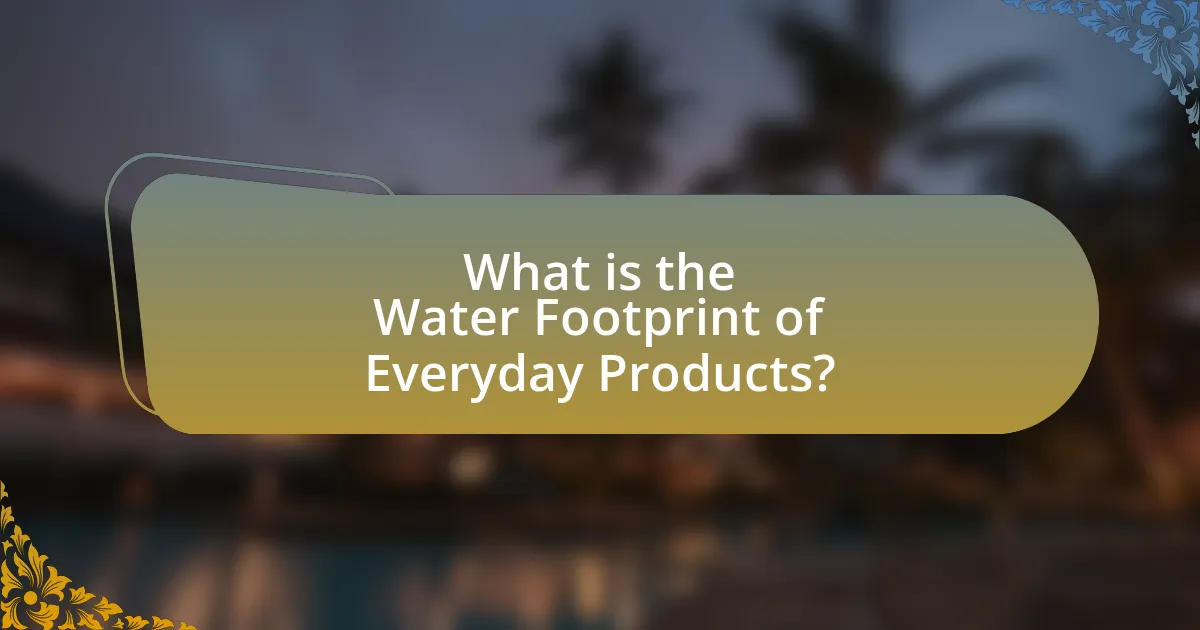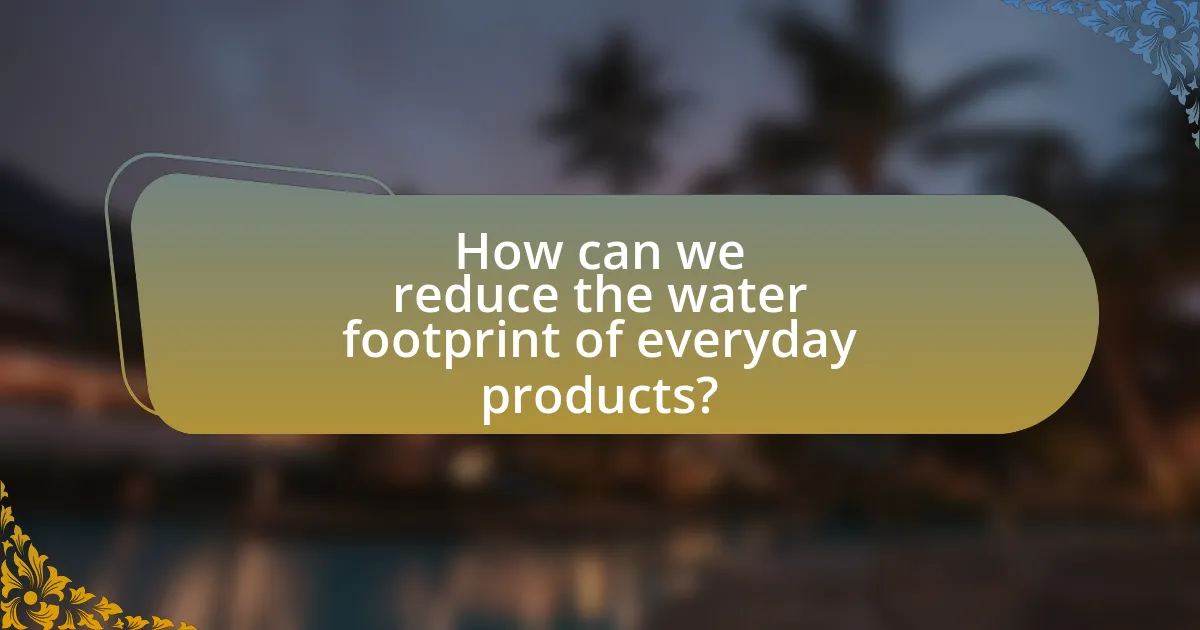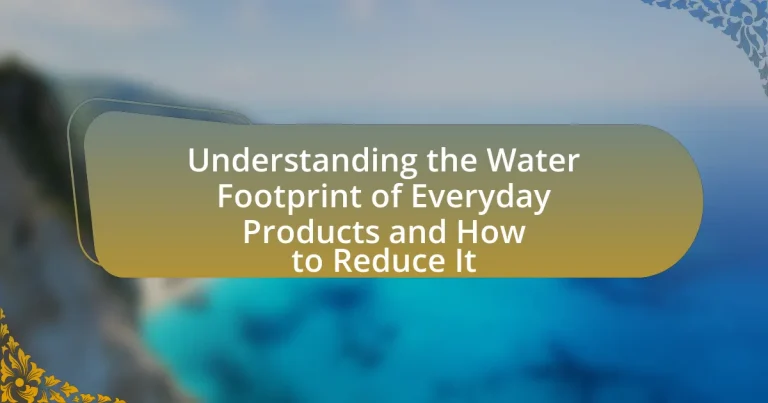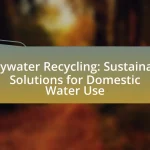The article focuses on the water footprint of everyday products, which quantifies the total volume of freshwater used in their production. It details how the water footprint is measured, including its components—blue, green, and grey water—and emphasizes the environmental impact of high water usage in products like beef and cotton. The article also discusses strategies for individuals and businesses to reduce their water footprint, such as adopting water-efficient practices and making informed product choices. Additionally, it highlights the importance of understanding water footprints for promoting sustainability and conserving water resources.

What is the Water Footprint of Everyday Products?
The water footprint of everyday products refers to the total volume of freshwater used to produce goods and services, measured in cubic meters. For instance, producing one kilogram of beef requires approximately 15,400 liters of water, while a cotton t-shirt has a water footprint of about 2,700 liters. These figures illustrate the significant water resources consumed in the production processes of common items, highlighting the importance of understanding and managing water usage to promote sustainability.
How is the water footprint measured?
The water footprint is measured by calculating the total volume of freshwater used directly and indirectly to produce goods and services. This measurement includes three components: blue water, which is surface and groundwater; green water, which is rainwater stored in the soil; and grey water, which is the amount of water required to dilute pollutants. According to the Water Footprint Network, the water footprint of a product can be quantified by assessing the water used throughout its entire supply chain, from raw material extraction to production, distribution, and consumption. This comprehensive approach allows for a clear understanding of the water resources involved in the lifecycle of products.
What are the different types of water footprints?
The different types of water footprints are categorized into three main types: blue water footprint, green water footprint, and grey water footprint. The blue water footprint refers to the volume of freshwater used in the production of goods and services, sourced from surface or groundwater. The green water footprint represents the amount of rainwater consumed during the growth of crops and vegetation. The grey water footprint indicates the volume of freshwater required to dilute pollutants to meet water quality standards. These classifications help in assessing the overall water usage and environmental impact of various products and activities.
How do we calculate the water footprint of a product?
To calculate the water footprint of a product, one must assess the total volume of freshwater used throughout its entire lifecycle, including production, processing, distribution, and disposal. This involves quantifying direct water use, such as irrigation for crops or water in manufacturing processes, as well as indirect water use, which encompasses water consumed in the supply chain, such as water used to grow feed for livestock. The water footprint is typically expressed in cubic meters of water per unit of product. Studies indicate that the water footprint of various products can vary significantly; for example, producing one kilogram of beef can require over 15,000 liters of water, while one kilogram of wheat may require around 1,500 liters.
Why is understanding the water footprint important?
Understanding the water footprint is important because it quantifies the total volume of freshwater used to produce goods and services, highlighting the environmental impact of consumption. This awareness enables individuals and organizations to make informed decisions that can lead to more sustainable water use practices. For instance, the water footprint of a single hamburger can be as high as 1,800 gallons, illustrating the significant water resources required for food production. By recognizing these figures, consumers can adjust their purchasing habits, advocate for water-efficient practices, and contribute to water conservation efforts.
What impact does the water footprint have on the environment?
The water footprint significantly impacts the environment by contributing to water scarcity, pollution, and ecosystem degradation. High water footprints from agricultural, industrial, and domestic activities lead to the depletion of freshwater resources, affecting biodiversity and the health of aquatic ecosystems. For instance, the production of one kilogram of beef requires approximately 15,000 liters of water, which can strain local water supplies and disrupt natural habitats. Additionally, runoff from agricultural practices can introduce pollutants into water bodies, further harming aquatic life and water quality.
How does the water footprint relate to sustainability?
The water footprint directly relates to sustainability by quantifying the total volume of freshwater used to produce goods and services, thereby highlighting the environmental impact of consumption. This measurement helps identify areas where water use can be reduced, promoting more sustainable practices. For instance, the water footprint of beef production can exceed 15,000 liters per kilogram, indicating significant resource use and prompting shifts towards more sustainable food choices. By understanding and managing water footprints, individuals and industries can contribute to water conservation and sustainable resource management, essential for maintaining ecological balance and supporting future generations.
What are some common everyday products with significant water footprints?
Common everyday products with significant water footprints include beef, cotton, and dairy products. For instance, producing one kilogram of beef requires approximately 15,000 liters of water, primarily due to the water needed for feed crops and animal hydration. Similarly, cotton cultivation consumes around 10,000 liters of water per kilogram, largely for irrigation. Dairy products also have a high water footprint, with the production of one liter of milk requiring about 1,000 liters of water. These figures highlight the substantial water resources involved in the production of these common items.
Which food products have the highest water footprints?
Beef has the highest water footprint among food products, requiring approximately 15,400 liters of water per kilogram produced. This significant water usage is primarily due to the extensive resources needed for raising cattle, including water for drinking, feed crops, and processing. Other food products with high water footprints include dairy products, particularly cheese, which can require around 5,000 liters per kilogram, and nuts, such as almonds, which need about 12,000 liters per kilogram. These figures highlight the substantial water resources involved in the production of these foods, emphasizing the importance of considering water usage in dietary choices.
How do clothing and textiles contribute to water usage?
Clothing and textiles significantly contribute to water usage through various stages of their production, including cultivation, processing, and manufacturing. For instance, the production of cotton, a common textile, requires approximately 7,000 liters of water to produce just one kilogram of cotton, highlighting the extensive water footprint associated with its cultivation. Additionally, the dyeing and finishing processes in textile manufacturing can consume thousands of liters of water per ton of fabric, further exacerbating water usage. According to the World Wildlife Fund, the fashion industry is responsible for about 20% of global wastewater, underscoring the environmental impact of clothing and textiles on water resources.

How can we reduce the water footprint of everyday products?
To reduce the water footprint of everyday products, consumers can choose products with lower water usage in their production processes. For instance, selecting foods that require less water to grow, such as vegetables over meat, can significantly decrease water consumption; producing one kilogram of beef requires approximately 15,000 liters of water, while one kilogram of vegetables may only require around 300 liters. Additionally, opting for products made from sustainable materials, such as organic cotton, which uses less water than conventional cotton, can further minimize water impact. Implementing water-efficient practices in manufacturing, such as recycling water in production, also contributes to reducing the overall water footprint of products.
What strategies can individuals adopt to minimize their water footprint?
Individuals can minimize their water footprint by adopting strategies such as reducing meat consumption, using water-efficient appliances, and practicing mindful water usage. Research indicates that producing one kilogram of beef requires approximately 15,000 liters of water, while plant-based foods typically require significantly less water. By shifting towards a more plant-based diet, individuals can substantially decrease their water usage. Additionally, using water-efficient appliances, such as low-flow showerheads and washing machines, can reduce water consumption by up to 50%. Mindful practices, such as turning off the tap while brushing teeth or taking shorter showers, further contribute to water conservation. These strategies collectively help individuals lower their overall water footprint effectively.
How can changing consumption habits help reduce water usage?
Changing consumption habits can significantly reduce water usage by promoting more efficient resource use and minimizing waste. For instance, adopting a plant-based diet can lower water consumption, as producing animal-based foods typically requires more water; it takes approximately 1,800 gallons of water to produce one pound of beef compared to just 200 gallons for a pound of vegetables. Additionally, reducing the frequency of laundry and using water-efficient appliances can further decrease water usage, as washing machines account for a substantial portion of household water consumption. By consciously choosing products with lower water footprints and practicing mindful consumption, individuals can collectively contribute to substantial water savings.
What role does product choice play in water conservation?
Product choice significantly impacts water conservation by determining the water footprint associated with the production and use of various items. For instance, selecting products that require less water for their manufacturing processes, such as organic cotton over conventional cotton, can lead to substantial water savings. Research indicates that producing one kilogram of conventional cotton can consume up to 10,000 liters of water, while organic cotton uses approximately 5,000 liters. Therefore, informed product choices can directly reduce overall water consumption and promote sustainable practices.
What are some effective practices for businesses to reduce their water footprint?
Businesses can effectively reduce their water footprint by implementing water-efficient technologies, optimizing processes, and promoting water conservation practices among employees. For instance, installing low-flow fixtures and water recycling systems can significantly decrease water usage. Additionally, conducting regular water audits helps identify areas for improvement, leading to targeted strategies that can cut water consumption by up to 30%, as reported by the Water Research Foundation. Furthermore, educating staff about water-saving practices fosters a culture of conservation, which can enhance overall efficiency and sustainability in operations.
How can companies implement sustainable water management practices?
Companies can implement sustainable water management practices by conducting comprehensive water audits to assess their water usage and identify areas for improvement. This approach allows companies to understand their water footprint, which is crucial for developing strategies to reduce consumption and waste. For instance, a study by the World Resources Institute indicates that companies can save up to 30% of their water usage by optimizing processes and investing in water-efficient technologies. Additionally, companies can engage in rainwater harvesting and wastewater recycling, which not only conserves water but also reduces costs associated with water procurement. Implementing these practices not only supports sustainability goals but also enhances corporate reputation and compliance with regulatory standards.
What innovations are being developed to reduce water usage in production?
Innovations being developed to reduce water usage in production include advanced irrigation technologies, water recycling systems, and drought-resistant crop varieties. Advanced irrigation technologies, such as drip irrigation and precision agriculture, optimize water delivery directly to plant roots, significantly minimizing waste. Water recycling systems in industrial processes allow for the reuse of water, reducing overall consumption; for instance, the textile industry has implemented closed-loop systems that can recycle up to 90% of water used. Additionally, the development of drought-resistant crop varieties through genetic engineering enables agriculture to thrive with less water, addressing the challenges posed by climate change. These innovations collectively contribute to a more sustainable approach to production, effectively lowering the water footprint of various industries.

What resources are available for further understanding and action?
Resources available for further understanding and action regarding the water footprint of everyday products include the Water Footprint Network, which provides comprehensive data and tools for assessing water usage in various products. Additionally, the book “Water Footprint: The Water We Use to Make Every Product” by Arjen Y. Hoekstra offers in-depth insights into the concept of water footprints. The United Nations Environment Programme (UNEP) also publishes reports and guidelines on sustainable water management practices. These resources collectively enhance knowledge and promote actionable strategies for reducing water footprints in daily life.
Where can individuals find tools to calculate their water footprint?
Individuals can find tools to calculate their water footprint on various online platforms, including the Water Footprint Network’s website, which offers a comprehensive calculator. This tool allows users to input their consumption habits and receive an estimate of their water usage. Additionally, organizations like the Nature Conservancy and the World Wildlife Fund provide similar calculators that help individuals understand their water impact based on lifestyle choices. These resources are validated by research in environmental science, emphasizing the importance of awareness in water conservation efforts.
What educational resources are available on water conservation?
Educational resources available on water conservation include online courses, government publications, and community workshops. Online platforms like Coursera and edX offer courses on sustainable water management, while organizations such as the Environmental Protection Agency (EPA) provide comprehensive guides and fact sheets on water conservation practices. Additionally, local governments often host workshops to educate residents on reducing water usage, which can include practical demonstrations and resource distribution. These resources are designed to raise awareness and provide actionable strategies for individuals and communities to minimize their water footprint.
What practical tips can help individuals and businesses reduce their water footprint?
To reduce their water footprint, individuals and businesses can implement several practical strategies. First, adopting water-efficient appliances, such as low-flow showerheads and dual-flush toilets, can significantly decrease water usage; for example, low-flow showerheads can save up to 2.5 gallons per minute. Second, optimizing irrigation practices by using drip irrigation systems and scheduling watering during cooler parts of the day can minimize water waste in landscaping. Third, individuals and businesses should regularly check for leaks in plumbing systems, as even small leaks can waste hundreds of gallons of water annually. Additionally, choosing products with lower water footprints, such as those made from sustainable materials, can further contribute to water conservation efforts. Lastly, educating employees and family members about water-saving practices fosters a culture of conservation, leading to more sustainable habits overall.


